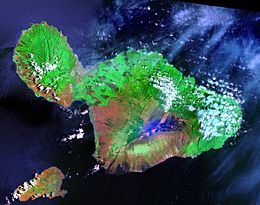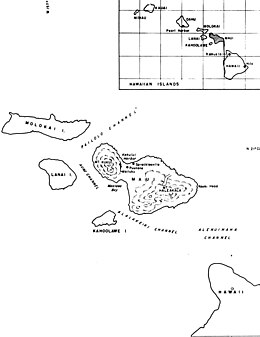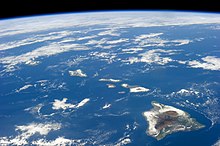
Back Maui Afrikaans ماوي (جزيرة) Arabic ماوي ARY Maui adası Azerbaijani ماوویی AZB Маўі (востраў) Byelorussian Мауи Bulgarian Maui Breton Maui Catalan Maui (pulo sa Tinipong Bansa) CEB
Nickname: The Valley Isle | |
|---|---|
 Landsat satellite image of Maui. The small island to the southwest is Kahoʻolawe. | |
 | |
| Geography | |
| Location | 20°48′N 156°18′W / 20.800°N 156.300°W |
| Area | 727.2 sq mi (1,883 km2) |
| Area rank | 2nd largest Hawaiian island |
| Highest elevation | 10,023 ft (3055 m)[1] |
| Highest point | Haleakalā |
| Administration | |
| Symbols | |
| Flower | Lokelani |
| Color | ʻĀkala (pink) |
| Largest settlement | Kahului |
| Demographics | |
| Demonym | Mauian |
| Population | 164,221 (2021) |
| Pop. density | 162/sq mi (62.5/km2) |

Maui (/ˈmaʊi/ ⓘ; Hawaiian: [ˈmɐwwi])[3] is the second largest island in the Hawaiian archipelago, at 727.2 square miles (1,883 km2). It is the 17th-largest in the United States.[4] Maui is one of Maui County's five islands, along with Molokaʻi, Lānaʻi, Kahoʻolawe, and Molokini.
In 2020, Maui had a population of 168,307, the third-highest of the Hawaiian Islands, behind Oʻahu and Hawaiʻi Island. Kahului is the largest census-designated place (CDP) on the island, with a 2020 population of 28,219.[5] It is Maui's commercial and financial hub.[6] Wailuku is the county seat and was the third-largest CDP as of 2010[update]. Other significant populated areas include Kīhei (including Wailea and Makena in the Kihei Town CDP), Lāhainā (including Kāʻanapali and Kapalua in the Lāhainā Town CDP), and Upcountry Maui (including Makawao, Pukalani, Kula, and Ulupalakua), although Lāhainā was mostly destroyed by fire in 2023.
Once part of Maui Nui, Maui is dominated by two volcanic features: Haleakalā in the southeast, and the West Maui Mountains in the northwest. The two are connected by an isthmus about six miles wide that gives the island its nickname, the Valley Isle.[7]
Maui has a significant tourism industry, with nearly three million visitors in 2022.[8] A 2023 report based on 2017 data concluded that nearly 40% of Maui County's economy was tourism-related.[9] Popular tourist destinations include the resorts in the Kāʻanapali, Kapalua, and Kihei/Wailea/Makena areas; Hāna and the Hana Highway; Iao Valley; Haleakalā National Park; and its many beaches.
- ^ Cite error: The named reference
ElevationRefwas invoked but never defined (see the help page). - ^ "Hawaii January 29, 2014". January 29, 2014. Archived from the original on January 10, 2015. Retrieved October 10, 2014.
- ^ Kinney, Ruby Kawena (1956). "A Non-purist View of Morphomorphemic Variations in Hawaiian Speech". Journal of the Polynesian Society. 65 (3): 282–286.
- ^ Cite error: The named reference
SizeRefwas invoked but never defined (see the help page). - ^ Cite error: The named reference
PopRefwas invoked but never defined (see the help page). - ^ Nyakundi, Colvin Tonya; Davidson, John (March 22, 2016). Traveling to Maui Island: The Ultimate and Most Comprehensive Guidebook. Mendon, Utah: Mendon Cottage Books. p. 193. ISBN 9781310226106. Retrieved May 14, 2020 – via Google Books.
- ^ Hornblower, Malabar (September 13, 1987). "A Historic Hub Where the Sun Sets on Maui". The New York Times. Retrieved November 14, 2023.
- ^ Tanji, Melissa. "2.9M visitors to Maui spent $5.69B in 2022". mauinews.com. Retrieved November 14, 2023.
- ^ Tian, Eugene; Kamita, Rene. "Tourism's Contribution to the State and County Economies in Hawai'i" (PDF). Hawaii Department of Business, Economic Development & Tourism. Retrieved November 14, 2023.
